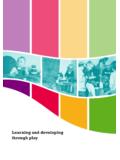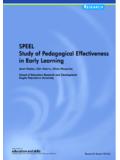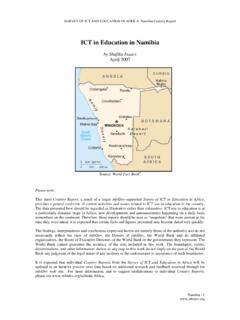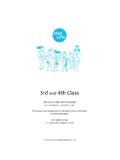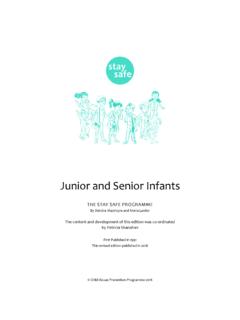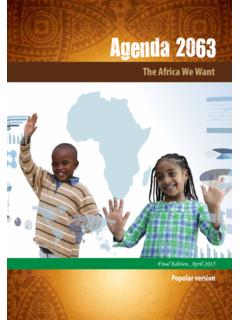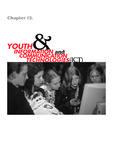Transcription of More than Computers: ICT in the Early Years - 327 …
1 Extract from: Developmentally Appropriate Technology in Early childhood (DATEC) Final Report also reproduced in Siraj-Blatchford, I. and Siraj-Blatchford, J. (2000) more than Computers: Information and Communications Technology in the Early Years , London, Early Education (The British Association for Early childhood Education) Children using ICT: the seven principles for good practice From their earliest Years , children should be finding out about and identifying the uses of technology in their everyday lives. They should also be using computers and programmed toys to support their learning.
2 Children need the opportunity to explore and play with computers just as they do with other forms of ICT, such as cassette recorders. This kind of play acts as the foundation for more structured use of applications later on. It means that ICT must be integrated across the curriculum. The key is to ensure that children have access to ICT which offers them opportunities to develop general skills and also extends their specific knowledge of that technology. Given the range of computer hardware and software now available on the educational and toy market it has become increasingly difficult to make informed choices between them.
3 DATEC s publication of guidance material for parents and practitioners is therefore calculated to provide for a pressing community need. It is based on research with practitioners and researchers in the field. A growing consensus has emerged regarding the most appropriate forms that ICT education should take in Early childhood . Seven general principles have been identified for determining the effectiveness of ICT applications or uses of ICT in the Early Years , to help practitioners provide the best possible experiences. They are: 1 ensure an educational purpose 2 encourage collaboration 3 integrate with other aspects of curriculum 4 ensure the child is in control 5 choose applications that are transparent 6 avoid applications containing violence or stereotyping 7 be aware of health and safety issues.
4 Parental involvement should also go hand-in-hand with these. Practitioners can use these points to engage in a discussion about each area and how it might fit into the general philosophy and practice of their setting. The guidance might also inform the setting s ICT policy, as it does in the sample policy on pages 00 00. The principles can also be used as a useful tool to evaluate software programs or other ICT applications, and also help with working with 1. Ensure an educational purpose Typical educational uses of ICT might be something as simple as the introduction of a pretend mobile telephone to encourage imaginative role play, which children from a very Early age will do quite naturally.
5 The educational benefits of imaginative role play are well documented. A favourite computer application with many children, is Make a bug from the CD-Rom Millie s Math House. This can be integrated as part of a more general class project, for example about insects and minibeasts. But any application introduced to children in order to develop understanding and experience of ICT should not just be enjoyable, although this is 1important. It should be educationally effective too. However entertaining most arcade-type games might seem, they provide little encouragement of creativity or, indeed, any other worthwhile learning outcome and should therefore be rejected.
6 This is not to suggest that applications should not be fun or used for leisure, only that they should be carefully chosen to have some educational value as well. Many settings and some homes use language and number drill-and-practice programs, but these have very narrow educational aims, such as practising addition or learning colours. Such programs should be used with caution, as they promote a very directive form of teaching, normally with the use of an external reward (a smiling face, a tick or a funny sound). Over-reliance on this kind of program risks reducing children s intrinsic motivation to learn.
7 In any event there are usually much more interesting ways of learning about these things (see Ensure the child is in control , below). Children need a variety of applications which encourage a range of development, including creativity, self-expression and language. Applications should be employed after a thorough discussion with staff and parents, wherever this is possible, about the educational benefits and constraints of the particular application. In common with many other Edmark programs, Millie s Make a bug operates in two play modes: free play and programmed learning.
8 In both cases, the names of the numbers and the body parts chosen are spoken , and one of these modes allows the child to play freely encouraging a creative response in a play environment that enhances their awareness of number. The application is therefore to be recommended for this facility alone. Unfortunately, the other mode provides a more problematic series of programmed learning exercises which are less desirable and should constantly be looked out for in programs In this more complicated mode, the rabbit in the picture frame gives the children specific instructions for making a bug.
9 The child then has to follow the instructions to make a bug with, for example, two feet and nine tails. If the child gets the answer wrong they have to select them correctly to continue with the game. There are two major problems with the program. First, it has some worrying limitations (for example, a child who has been instructed to make four tails, and who does so by adding two tails with another two tails, will be told that she is wrong). So, children who approach tasks in less conventional ways will be given negative responses to their sometimes-ingenious solutions. Such limitations in ICT programs need to be looked out for and may cause practitioners to reject them.
10 Second, the exclusive use of external authoritative praise does little to encourage self-motivation or perseverance on the part of the child. (The bunny simply says Good job or You re really good at this when the child gets something right, and whoops when things go wrong.) 2. Encourage collaboration While it is important for children to play alone (and they do this very well), an indicator of quality play, according to Bruce (2001), is also playing collaboratively. There are parallels in the world of computer use. Children can access programs individually, but the best applications provide a valuable means of encouraging collaboration.

